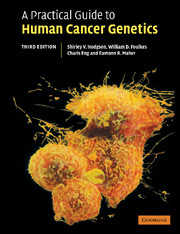Book contents
- Frontmatter
- Contents
- Dedication
- Preface
- Acknowledgements
- Part one Cancer genetic counselling
- Part two Genetics of human cancers by site of origin
- 2 Central nervous system
- 3 Eye
- 4 Cardiorespiratory system and thorax
- 5 Endocrine system
- 6 Gastrointestinal system
- 7 Reproductive system
- 8 Urinary system
- 9 Blood and lymph
- 10 Musculoskeletal system
- 11 Skin
- Part three Cancer-predisposing syndromes
- Appendix
- References
- Index
7 - Reproductive system
Published online by Cambridge University Press: 20 August 2009
- Frontmatter
- Contents
- Dedication
- Preface
- Acknowledgements
- Part one Cancer genetic counselling
- Part two Genetics of human cancers by site of origin
- 2 Central nervous system
- 3 Eye
- 4 Cardiorespiratory system and thorax
- 5 Endocrine system
- 6 Gastrointestinal system
- 7 Reproductive system
- 8 Urinary system
- 9 Blood and lymph
- 10 Musculoskeletal system
- 11 Skin
- Part three Cancer-predisposing syndromes
- Appendix
- References
- Index
Summary
Breast cancer
Background: epidemiology and family history
Breast cancer is the most common cancer in women, accounting for 20 per cent of all new cases of cancer. The lifetime risk of breast cancer in the UK is one in nine females, with an incidence of <10 per 100,000 women aged <30 years, rising to 300 per 100 000 in women aged over 85 years. Similar, but slightly higher rates are seen in North America. It is rare in men (<1 per 100 000). Breast cancer incidence shows marked geographical variation: it is much less common in Asian than in Caucasian women, and less frequent in South America and Spain than in Northern Europe, North America and Australia. In India, the prevalence is lower (although rising) except amongst Parsee women. In North America, the incidence of breast cancer appears to have increased in recent years; some of this increase is due to mammographic detection of ductal carcinoma in situ leading to early diagnosis of minimally-invasive ductal carcinoma.
In 1948, Penrose and colleagues observed that breast cancer may have a hereditary basis in some families (Penrose et al., 1948). A genetic influence on breast cancer susceptibility is suggested by twin studies, as the concordance for breast cancer in identical twins (0.28) is more than twice that in dizygotic twins (0.12) (Petrakis, 1977; Bishop and Gardner, 1980).
- Type
- Chapter
- Information
- A Practical Guide to Human Cancer Genetics , pp. 67 - 111Publisher: Cambridge University PressPrint publication year: 2006

